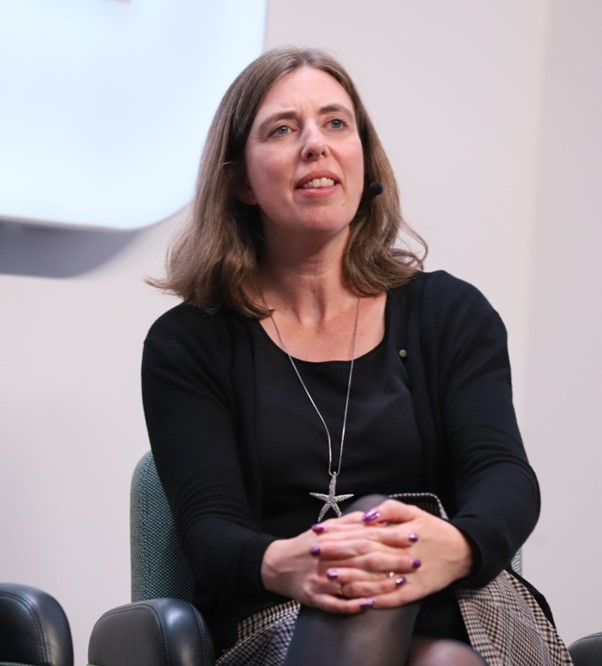I’m delighted that my guest this month is Holly Tuke, a disability blogger, freelance writer and charity comms professional. She shares with us how the kindness of accessible communications makes her feel, as a person living with a visual impairment. She also provides some top tips for resources to help you make your comms as accessible as possible.
Accessibility is the building blocks of my life; it gives me access to the online and offline world. As a blind communications professional, freelance writer and disability advocate, I’m all too familiar with both accessible and inaccessible communications. When you combine those elements of my life, you’ll find me talking about accessibility a lot.
Feelings of inclusion and belonging
It’s not an understatement that accessibility transforms my life. It gives me access to the world just like sighted people, even if it sometimes is in a different way. It means that I can keep in touch with my family and friends, spend far too much time scrolling through social media, doing some online shopping, and most importantly, it means that I can do my job and freelance work.
Accessible communications make me feel included. They mean that I can access the information that’s being shared, and give me the option to be part of conversations.
When something is accessible, it gives me a sense of joy and happiness. I’m made to feel included, and wanted in that space. It tells me that people care. And that’s so important. We should all feel like we belong, both online and offline.
Yet both personally and professionally, something I often see is inaccessible communications. A lack of accessibility means that the building blocks are removed. I’m talking about social media content, marketing materials, websites…the list doesn’t stop there.
Whether you realise it or not, accessibility is part of everything we do. Or at least it should be.
Scroll on by
“Image”.
That’s what my screen reader announces whenever I’m scrolling through social media and there’s an image without alt text.
Alt text, often referred to as alternative text, is a written description of an image, making them accessible to blind people like me. They describe what’s going on in the photo which is then read out loud by my screen reader.
My screen reader converts text to speech, reading out loud what’s on the screen on my phone, laptop or iPad. It is the foundations of me being able to use those devices in the first place.
Images without alt text, hashtags which don’t use Camel Case (where the first letter of each word is a capital), posts that have far too many emojis and fancy fonts are just some of the issues I come across on social media every single day.
When communications aren’t accessible, I’m often left with no choice but to scroll by, taking away my access. To you it might seem like an insignificant social media post, yet to me, it leaves me feeling excluded and frustrated. Let me decide whether it’s insignificant or not.
The power of accessibility
Accessibility gives me a warm, fuzzy feeling inside; particularly when a well-known celebrity or brand make their content accessible. Take comedian Sarah Millican or the Nasa Twitter account for example. Sarah takes the time to add alt text to all of the photos she posts on social media. She’s a brilliant example of a disability ally. I wish more celebrities would follow in her footsteps.
The Nasa social media team write alt text that’s truly a work of art – the time, care and dedication that go into their alt text is unmatched.
Take a look at the image descriptions from WeRateDogs, because everyone should be able to enjoy the adorable pet photos!
What if we all set that exemplary standard? How incredible would our social media platforms be? Our feeds would be filled with the most beautiful, creative alt text. From where I’m standing, that would be extremely powerful. Not forgetting inclusion would be at the heart of our online content which in itself would transform our online spaces.
It’s not just on social media it has impact – your newsletters, websites, documents and presentations all play a part. You name it, it needs to be accessible. I’d love to see accessibility become the norm.
Accessibility is more than the practical tips we should be following every day. Its impact is much bigger than we can imagine.
Inclusion should be at the centre of why we make our content accessible. Everyone should feel included. It goes a long way. If we all made our comms accessible, the online world would feel more welcoming. It would feel like a kinder place full of acceptance, love and respect.
Help us get there by making your communications accessible!
Accessibility and inclusion equal kindness.
Not sure where to start with accessible, inclusive communications?
Check out these resources.
- Your A-Z guide for social media accessibility
- Accessible Social
- Accessible communications: A starting point for fostering more inclusive comms – CharityComms
Holly Tuke is a disability blogger and freelance writer. She also works as a communications professional within the charity sector. She is the author of the blog Life of a Blind Girl which she started in 2015 as a platform to share her experiences of living with a vision impairment, educate others and tackle the misconceptions surrounding disability. Away from the blog and freelance writing, Holly enjoys going to concerts, spending time with friends and family, and relaxing with a good audiobook.

Let's work together
Bring kindness to life with workshops, talks and other support that make a real difference — boosting wellbeing, improving performance and creating lasting positive change.
Find out how
